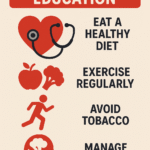
Harnessing AI Collaborations to Prevent Diabetic Blindness
AI in Preventing Blindness: A Game-Changer
The Importance of AI in Healthcare
The AI technology being released is personalized; for example, it has already revolutionized how we treat diabetic retinopathy, one of the leading causes of blindness. This issue is crucial because:
- Diabetes continues to be the fastest-growing disorder among people in the whole world, which contributes to the growth of the at-risk population.
- Vision loss, on the other hand, reduces independence, causes mental disorders, and the patient can also lose his job due to the disease.
Relevance for Key Stakeholders
For patients, this is an assurance of their vision and the life they lead. The researchers are also supplied with all the raw data that can be utilized to think critically about how the new disease can be treated. Healthcare providers can achieve the patient care they provide by detecting problems even before they become severe.
- Hope for prevention: AI will be given more control over complex systems, allowing the machines to find and solve problems independently.
- Efficiency improves: Work processes are automated with computer assistance to save time and resources.
Historical Context of AI in Preventing Blindness
Evolution in Healthcare
The importance of using artificial intelligence in healthcare to prevent blindness is a significant turning point in the medical world.
- Initially, it was only an illusion: Nowadays, AI even surprises and sometimes understands human behaviour with developing technology in diagnostics and treatment.
- Cooperative projects have given rise to brilliant technologies that can help patients get better outcomes.
Impact on Medicine and Public Health
AI is not confined to being just a gadget; it is a real revolution in medicine and public health.
- Outdated screening procedures are no longer the world health officials have sexed with imaging diagnostic machines. They are much more capable of detecting early conditions.
- Appropriate remedies are discernible by patients and are what minimize healthcare disparities.
- AI is an excellent tool for the prevention of complications.
- In this tri-state area, AI technology is an emerging process, which is the most significant event ushering a new era of the union of technology and human healthcare to the service of sight preservation and the promotion of health equality.
Current Landscape of AI in Preventing Blindness
Innovations Steering Change
AI is reforming the way people are treated. Immediate evaluation of optical pictures allows for discovering the first symptoms before they become crucial.
- Swift processing: AI discovers ailments within moments.
- Preciseness: Reducing human errors so that the number of spotted faults rises by 30%.
- Mobility: Rural areas can now secure a second opinion from a specialist.
The Collaborative Approach
Healthcare institutions are now moving from competition to collaboration. Health organizations are joining hands in making new approaches in which AI’s capabilities will be utilized with the following technologies:
- Education: Educating residents on the risk factors.
- Screening: Automatic reminders are sent out, and 40% more patients participate in the screening.
- Research: Data exchange drives innovations.
- In summary, AI is more than a mere gadget; it is part of the hope to enjoy a future full of bright days in the face of the danger of sight loss!
Impact of AI on Eye Health
Transformative Change in Vision Care
In current technology, AI has reshaped clinical findings and has become beneficial in preventing blindness, particularly in conditions such as diabetic retinopathy. There could be a world where high-tech technology will be innovative enough to diagnose patients’ eye conditions before they have any symptoms.
- Faster Detection: AI systems scan retina photographs and can easily find the defects that may have occurred in the retina, which could help stop them.
- Improved Treatment: The yearning to live an excellent life becomes a reality through interventions over time.
Empowering Patients and Families
This approach is advantageous to the individual and gives peace of mind to their family members.
- Just think how great it would be if you got a message
- “It’s OK; Your eyes are fine now. AI checked them for you.”
- Instantly, one’s life transforms into light and joy through encountering inner and outer clearness….
Public Health Benefits
The welfare of the general public is fundamentally improved as a result of:
- Lower Healthcare Costs: By preventing the early stages of the disease, expensive major surgery can be avoided.
- Greater Accessibility: Such AI tools should be introduced in regions not served by existing existing existing existing existielemedicine projects to cater to all the populations who are visually impaired.
- AI is not merely a technological aspect; it’s about liberating folks from this, thus ameliorating general medical conditions.
Impact of AI on Healthcare Professionals
AI answers most problems linked to visual impairment, especially diabetic retinopathy. It is an excellent opportunity for the medical staff to discover new tasks.
Challenges
- Training Costs: Being trained and specialized in advanced AI tools is necessary, and it can financially affect many health systems.
- Implementation Issues: Connecting AI to the prevailing business process disrupts most methods they usually use.
Opportunities
- Resource Management: With AI, resources can be allocated more precisely to where they are needed; this results in more efficient use of staff and availability of beds for overflow patients.
- Enhanced Patient Care: AI can be used by doctors, nurses, and other caregivers to provide timely intervention that can save lives eventually when treating patients and performing surgeries safely and successfully.
- In summary, AI’s role in healthcare is clear: it is a tough love that calls for training and regulation in its implementation, but at the same time, it is the best way to reach the patient. Five years from now, let the computer do the dull or dangerous work and focus on the rest of the task.
The Trend of AI in Preventing Blindness
Key Benefits
The introduction of AI into medicine for diabetic retinopathy, a leading cause of blindness among diabetes, stands out for its potential to prevent vision loss. This is attributed to AI as the subsequent factors have transformed this traditional approach into digitized solutions:
- Enhanced Efficiency: Clinics can now quickly assess thousands of patients with possible vision problems to process large numbers of patients without long waiting times correctly.
- Improved Patient Outcomes: Artificial intelligence will help be the game-changer and turn one of the most crucial elements of early diagnosis into the key factor.
- Collaborative Innovations: This alliance’s key partners, hospitals, and technology companies develop applicable and scalable solutions.
- Currently, utilizing AI in medicine is not only a wise act but an absolute necessity to secure a healthier society.
Challenges and Ethical Concerns in AI for Preventing Blindness
Patient Perspectives
- Privacy Issues: Also, the use of technology has brought about issues regarding safety and privacy in the health sector. For instance, patients’ medical records might be infringed upon by unauthorized third parties who collect, use, and sell them without patients’ consent.
- Accessibility: Unfortunately, the main obstacle to AI being effectively distributed for personalized medicine is that not everyone has the same level of access, which can result in health disparities.
Researcher Concerns
Data Bias: AI systems trained on non-diverse datasets are likely to make mistakes when foreshadowing the problems in minority groups.
- Mistakes in Diagnosis: Overdependence on AI without including humans can aggravate misdiagnosis issues.
Regulatory Challenges
- Lack of Guidelines: Concerns about the absence of laws on AI-related issues are genuine; this suggests the topic of AI should be on the top agenda for the whole day.
- Quality Control: The control of AI-generated tools to perform at the required safety and effectiveness is yet another problem.
Navigating the Future
Vremenska doplĉa o kojima govorimo menjaju se skoro jednako brzo kao zapad koji je postao toliko ludačkim da mu samo pomoć bog može. Eto takve nepoznanice su najvažnije. Možemo stalno da gledamo hoće li ih uspeti da reše ljudi ili je to veɣ jedan od razloga evolucije slaboumnosti. Ono što se najɩe͓ɣe de͓ava je to da mi obiɩno postavljamo pitanja i da budemo spremni da ih brzo re͓imo jer nemamo dovoljno vremena za razmišljanje.
Embracing AI to Prevent Blindness
How to Get Involved
You can play a vital role in this life-changing initiative. Consider these action steps:
- Stay Informed: Keep up with the technological advances in AI medicine. Knowledge is power!
- Engage in Awareness Campaigns: Spread information about diabetic retinopathy among your friends or through social media. Sharing is caring.
- Join Online Platforms: Be active in online communities where AI applications and eye health care are discussed.
- Advocate for Collaborations: Be a pioneer in this field and pour everything you have into tech and health projects. Wild imagination might be the key to success here. Get together all the like-minded people and create this as a health movement using technology. Your voice matters!
The Future of AI in Preventing Blindness
A New Era of Vision Health
Artificial intelligence is transforming how we approach diabetic retinopathy prevention, the first cause of blindness. This change allows for creative inventions and the advent of new employment opportunities.
- The healthcare sector is witnessing significant technological advancements, with companies like Pershi Micron and Japan Medical Award stepping in to advance the cause by leveraging AI technologies.
- AI can carry out the most accurate analysis of the retina scans, thus discerning problems while they are in their infancy.
- Booming segments like data science and machine learning are vital in healthcare. From this view, the outlook is bright as technology now brings about progress and the collective improvement of our lives.
Understanding AI’s Role in Preventing Blindness
Key Takeaways
Notably, AI is changing the spectrum of ophthalmology, particularly in the area of diabetic retinopathy disease. Here are your list of pros and cons for the case:
- Time is the essence of the matter. AI tools diagnose the problems at their least harmful stages.
- Strategic partnerships are the way to get the job done swiftly.
Engage and Stay Informed!
Continuous education and open communication with a health provider should not be missed. Ask your specialist what AI technologies can do in your case and get acquainted with the benefits. Adopting these trends will secure your sight for years to come!












Post Comment